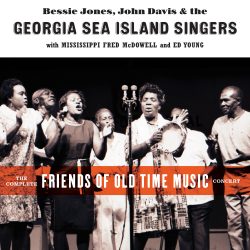How a live recording of a concert can preserve one powerful moment indelibly in time.
 “We are on the road to world peace, freedom, and integration”, declares ethnomusicologist Alan Lomax in 1965, as he introduces this historic concert. With songs which were encoded with powerful messages of resistance to slavery and oppression, the powerful subtext of the concert was crystal clear, even then. From behind him on the stage, however, some of the greatest Black folk singers of their time say nothing. Their thoughts on Lomax’s overly optimistic prediction were to come through in the songs they presented that evening. Songs that prayed to a Biblical God for justice, songs that spoke of the pure barbarity and horror of slavery, the death and murder of so many brought from Africa over the centuries, songs that spoke of the thousands and thousands of marchers in America at that very time during the Civil Rights movement.
“We are on the road to world peace, freedom, and integration”, declares ethnomusicologist Alan Lomax in 1965, as he introduces this historic concert. With songs which were encoded with powerful messages of resistance to slavery and oppression, the powerful subtext of the concert was crystal clear, even then. From behind him on the stage, however, some of the greatest Black folk singers of their time say nothing. Their thoughts on Lomax’s overly optimistic prediction were to come through in the songs they presented that evening. Songs that prayed to a Biblical God for justice, songs that spoke of the pure barbarity and horror of slavery, the death and murder of so many brought from Africa over the centuries, songs that spoke of the thousands and thousands of marchers in America at that very time during the Civil Rights movement.
“If I can’t march, I can sing“, said Mable Hillery of the Georgia Sea Island Singers, herself a noted Civil Rights activist and frequent marcher who had stayed back from protests to testify before this crowd of mostly young, white people in New York City. Their collective mission was to help people understand what slavery was, where this music was coming from and how it could inform the future.
The “Complete Friends of Old-Time Music Concert” is not just a live recording but a previously unheard, historically significant document. This unique piece of history that captures the reality of the Black American experience through folk songs is a captivating intersection of Black folk traditions and civil rights activism. In the midst of the Civil Rights Era, they used a range of songs, from Biblical to apocalyptic, to make a potent and specific point about the past horrors and the change needed for justice in the present and future.
The album is a rich tapestry of traditional music featuring a variety of genres from the Island and beyond. It includes stirring work songs, emotionally charged spirituals, jubilant songs for children, and revelatory renditions of Mississippi blues. Four of the songs, in particular, released in advance of the album, provide a vivid narrative of the history these artists aimed to convey, adding depth and context to the overall experience.
“Buzzard Lope (Dance)“, sung by Bessie Jones, John Davis, & The Georgia Sea Island Singers, is one of the most haunting songs on the album. A spiritual dance with African origins, this folkloric song reflects the horror and humiliation of enslaved black people whose bodies were thrown in the fields to rot rather than buried in the time of slavery. Singers would gather in a circle, cloth representing the body; as they danced, individuals would enter the circle and mimic the buzzard by snatching the cloth.
“Read ‘Em John,” sung by John Davis, Bessie Jones, and The Georgia Sea Island Singers, can be traced to emancipation. It speaks of the one enslaved person who could read being asked to read the letter telling the other enslaved people that they were now free. It is a simple but lively celebration packed with sheer joy and enthusiasm.
“Chevrolet“, from the early recorded blues tradition, is a 1930 Memphis Minnie song sung here by Ed Young and Emma Ramsey. Young’s fife playing ties it back to the Mississippi fife and drum tradition that traces back to the Civil War. The fun song, however, is about a brand new Chevrolet and the coming of new technology and was recently made famous when Mary J. Blige sang it a cappella in a 2017 Super Bowl ad.
“Marching on the Mississippi Line” is sung by Mable Hillery and Emma Ramsay. Hillery was part of The Georgia Sea Island Singers, but she was also participating in freedom-song teach-ins in the South during the Civil Rights Era. Having spoken about how she couldn’t be out marching because she was at this concert instead, she brought together Biblical ideals with modern politics for a song that still resonates today.
It was a star-studded concert, and the excitement of these seminal musicians joining together on songs and inspiring each other in this live recording is palpable. They clearly revel in playing together, having found common ground across very different Black communities in America. The spoken introductions to the songs capture the traditions of the time, and the musicality, mainly through handclapping, flutes, and stringed instruments, is wholesome and moving as the performers and audience alike put their all into the evening.
The recognition and foresight of this movement in 1965 were brave and groundbreaking, yet, astonishingly, some sixty years later, the fight for freedom from slavery and oppression in its many forms continues across the globe. Despite being acknowledged for centuries, the release of this live recording is a pertinent, valuable reminder that the job is far from done.


